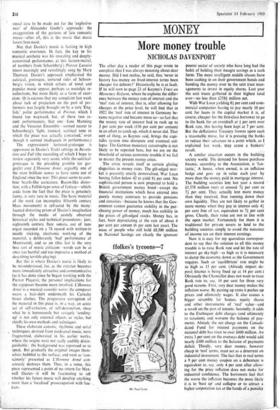Demolition squad
MUSIC MICHAEL NYMAN
Any dedicated anti-modernist—one of the many who condemn today's music as discordant, noisy and tuneless—venturing on to the South Bank last week would have been puzzled. For there, in the first of his 'Contemporary Pianist' re- citals, John Tilbury was to be heard quietly playing Victorian trifles where the programme
said Stockhausen; while a 'difficult' composer like Peter Maxwell Davies could entertain his audience with both his music and his analysis of the way it was put together—such delicacies as Purcell dances, dished up in the style of 'twenties foxtrots and seen through the eyes of a serious composer of the 'sixties. There the chance similarity ends, for Tilbury's 'putting on the style' was an idiosyncratic interpretation of somebody else's piece, while Davies's 'historic- ism' is central to the very fabric of his music. They do share, however, an element of musical destructiveness.
For Tilbury's version of Plus-Minus was dis- pleasing to the addict through his deliberate avoidance of the Stockhausen style—even though he kept more or less strictly to the rules of the piece. These rules are a sort of musical recipe in which the basic ingredients are first given, then mixed, added to and subtracted from by the interpreter: the final meal being there- fore unpredictable. Tilbury chose to spin out the basic material as a long succession of the kind of tunes one busks for an unwilling pubes- cent dancing class, and—in the unlikely context of a Stockhausen-type time scale with a not par- ticularly integrated tape part—lie succeeded both in deflowering this innocent material, and in destroying Stockhausen's piece too.
I suppose that what one makes of the joky, eccentric, selectively eclectic, brilliant exterior of Peter Maxwell Davies's recent music depends to a certain extent on one's own personal in- terest in, and identification with, 'the musical objects—largely mediaeval and renaissance— that he chooses to subject to his compositional alchemy; and, on a more fundamental level, on whether these objects are important enough to anyone but the composer to be worthy of such destruction. To me they are, but there is an
equal case to be made out for the 'explosive- ness' of Alexander Goehr's approach: the exaggeration of the gestures of late romantic music—after all, this is the music that music lovers love most.
Not that Davies's music is lacking in high romantic overtones. In fact, the key to his musical aesthetic was his revealing and deeply- committed performance, at this lecture-recital, of numbers from Schoenberg's Pierrot Lunaire (most movingly and ravishingly sung by Mary Thomas). Davies's approach emphasised the satirical, grotesque, tortured sides of Schoen- berg's vision, in which echoes of tonal and popular music appear, perhaps as nostalgic re- collections, but more likely as a form of exor- cism. (It is curious that my complaint last week about lack of projection on the part of per- formers was largely brought on by a very 'Eng- lish,' polite performance of Pierrot, which I found too wayward, but, of these two re- cent performances, that one—Jane Manning and the Vesuvius Ensemble—seemed nearer to Schoenberg's 'light, ironical, satirical tone in which the piece was actually conceived,' even though it seemed inadequate in performance.)
The expressionist tortured-grotesque is uppermost in Davies's Trakl settings in Revela- tion and Fall (the recording of which I hope to review separately very soon), while the satirical- grotesque is the presiding gremlin (or gar- goyle) over L'Homme Anne, arguably one of the most brilliant scores to have come out of England since the war. This piece seems to com- bine Scarfe-like caricature, Bacon-like distor- tion, with a Fellini-type sense of fantasy—which, aside from the fact that the piece is genuinely funny, is very rare in music. The basic material of the work (an incomplete fifteenth century Mass movement) is refracted by the many- faceted distorting prism of Davies's imagination through the media of acutely observed historical styles and technical procedures : jazz, eighteenth century flute sonata, out of tune organ recorded on a 78 record with written-in needle sticking, electronic working of the material, a deliberately 'bad' performance of Monteverdi, and so on (this last is the very best sort of music criticism--words can be at once too hurtful and too imprecise a method of
describing terrible playing). .
But this is where Davies's music is likely to be misunderstood, for, as the exterior becomes more immediately attractive and communicative (as it has done since he began working with the Pierrot Players), the personal implications for the copposer become more involved. L'Homme Arnie is a musical comedic noire: the composer wears a hair-shirt underneath his Carnaby Street clothes. The progressive corruption of the material in this piece is, in a way, an acute act of self-criticism, of self-destruction, since what he is humorously but savagely 'sending- up' is not only external objects or styles, but chiefly his own methods and techniques.
These elaborate canonic, rhythmic and serial techniques, derived from mediaeval music, were fragmented, elaborated in his earlier works,
where the origins were not really audibly distin- guishable : the background was repressed so to
speak. But gradually the original images them-
selves bubbled to the surface, and were as 'con- sciously' presented as L'Homme Arnie con-
sciously destroys them. Thus, in a sense, this piece represented a point of no return for Max- well Davies—it will be fascinating to set whether his future music will develop anything more than a 'localised' preoccupation with fox, trots.



































 Previous page
Previous page